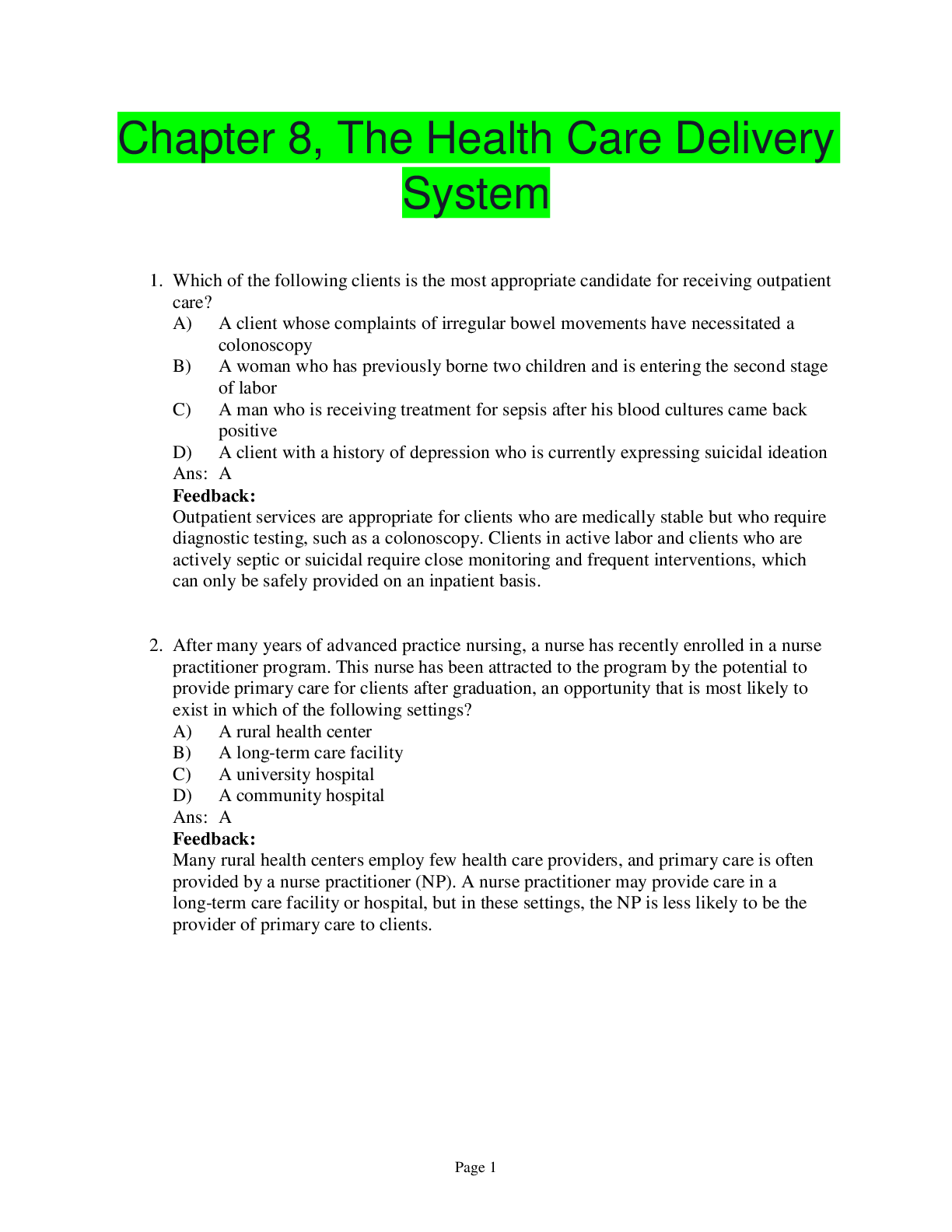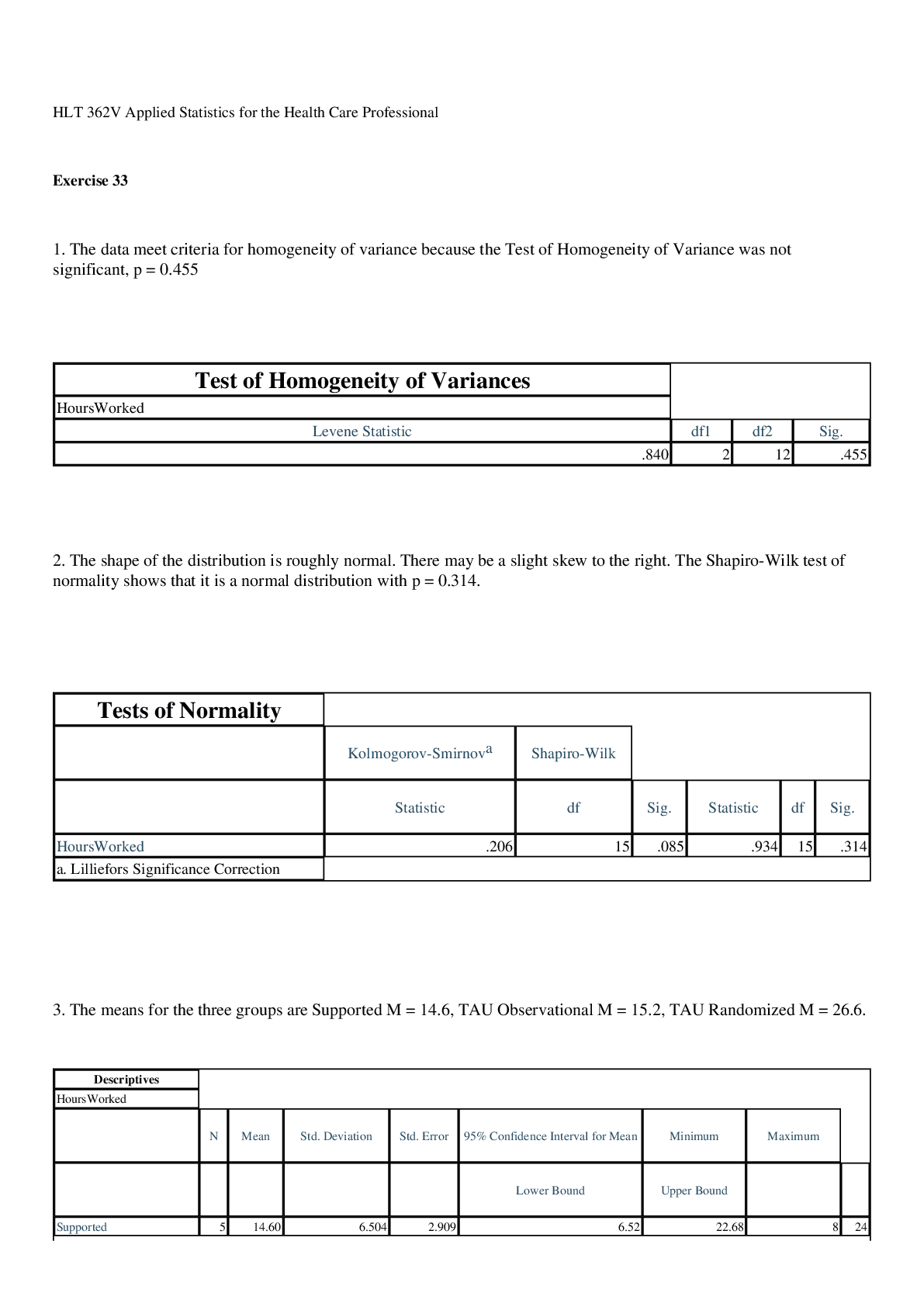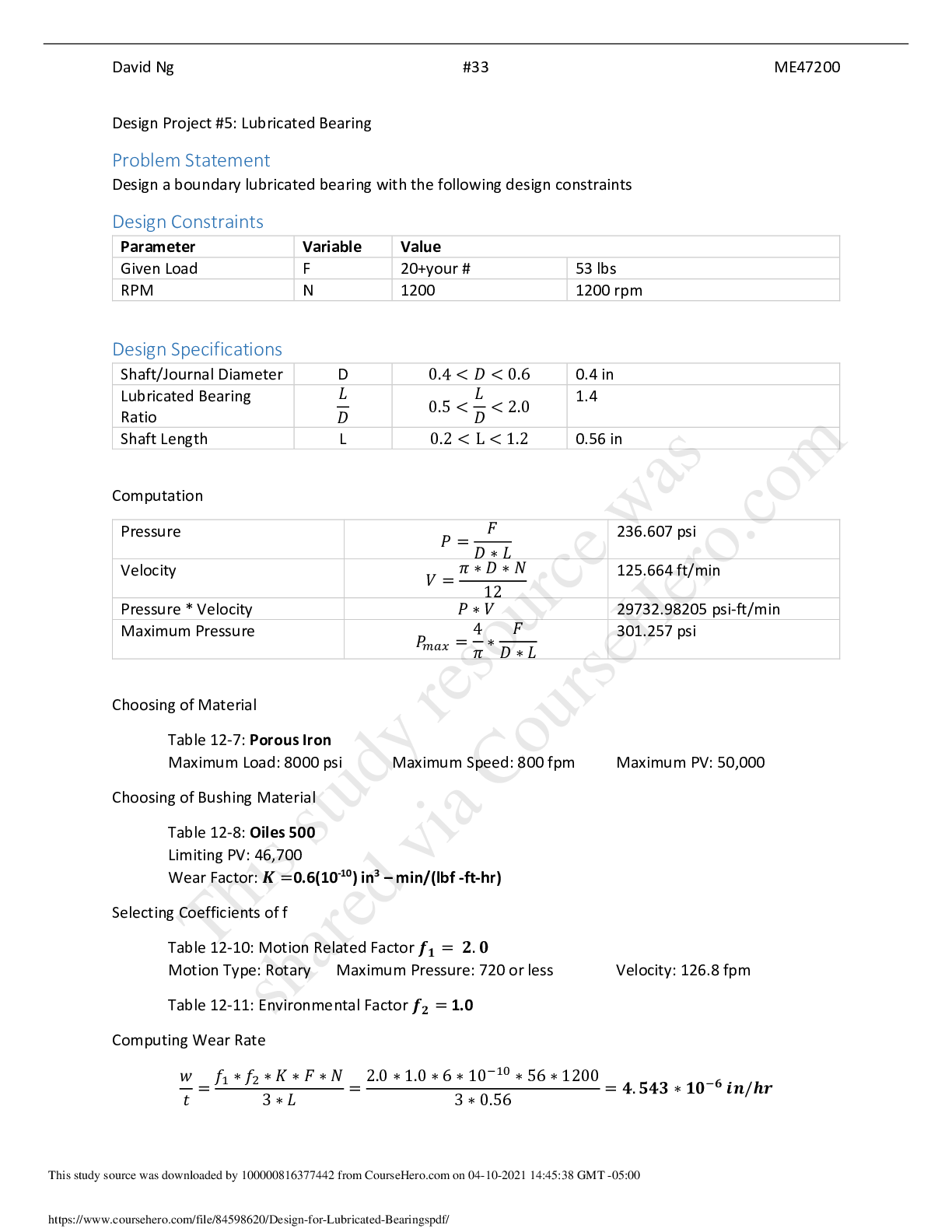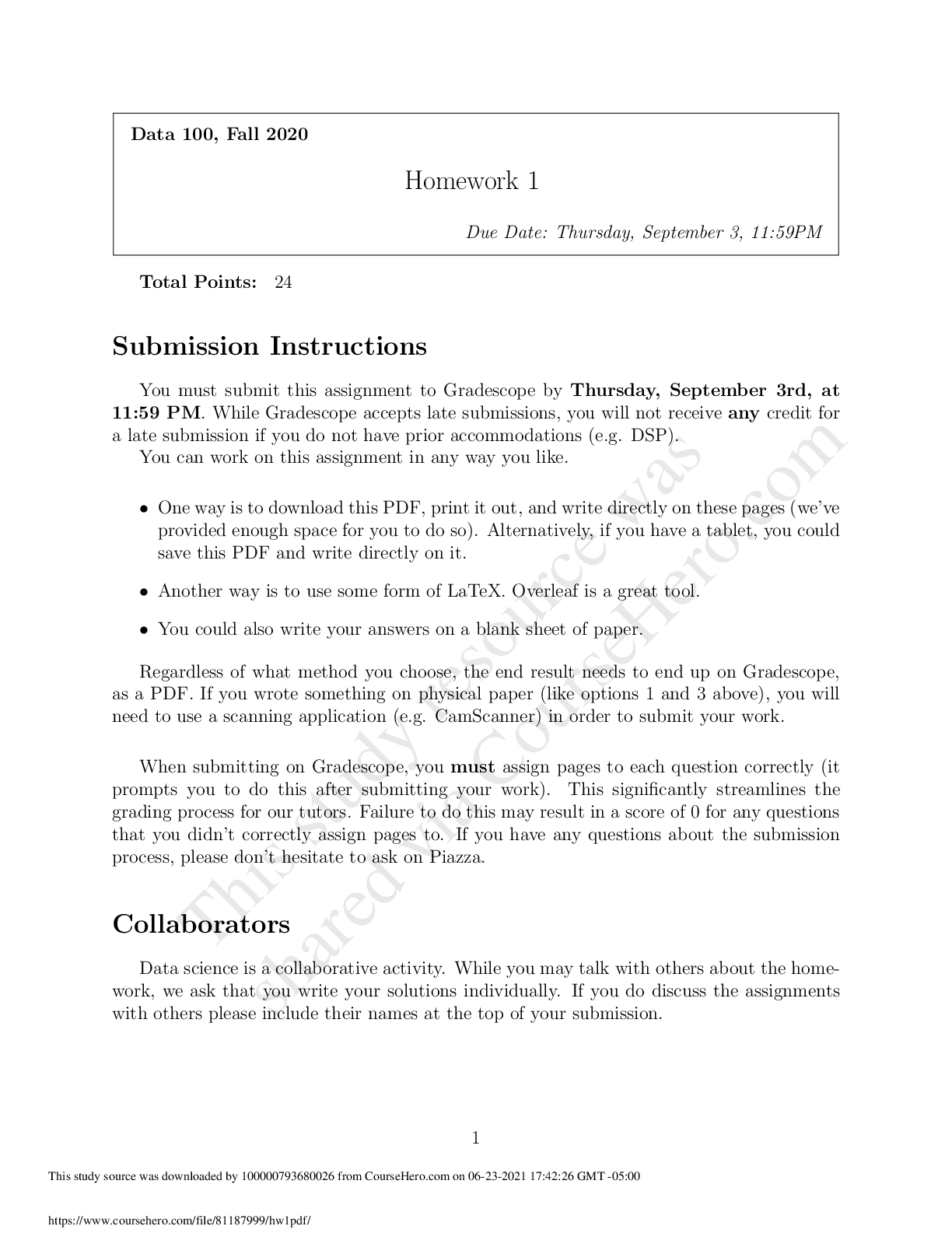*NURSING > QUESTIONS & ANSWERS > New York City College of Technology, CUNY - NURSING 119Chapter 8, The Health Care Delivery System (A (All)
New York City College of Technology, CUNY - NURSING 119Chapter 8, The Health Care Delivery System (ALL CORRECT ANSWERS)
Document Content and Description Below
Chapter 8, The Health Care Delivery System 1. Which of the following clients is the most appropriate candidate for receiving outpatient care? 2. After many years of advanced practice nursing, a nu... rse has recently enrolled in a nurse practitioner program. This nurse has been attracted to the program by the potential to provide primary care for clients after graduation, an opportunity that is most likely to exist in which of the following settings? 3. Which of the following phrases best describes hospitals today? A) Focus on chronic illnesses B) Focus on acute care needs C) Primary care centers D) Voluntary agencies 4. A man is scheduled for hospital outpatient surgery. He tells the nurse, "I don't know what that word, outpatient, means." How would the nurse respond? A) "It means you will have surgery in the hospital and stay for 2 days." B) "It means the surgeon will come to your home to do the surgery." C) "Why would you ask such a question? Don't worry about it." D) "You will have surgery and go home that same day." 5. A nurse in a walk-in health care setting provides technical services (e.g., administering medications), determines the priority of care needs, and provides client teaching on all aspects of care. Which of the following terms best describes this type of health care setting? A) Hospital B) Physician's office C) Ambulatory center D) Long-term care 6. Nurses who are employed in home care have a variety of responsibilities. Which of the following is one of those responsibilities? A) Provide all care and services B) Maintain a clean home environment C) Advise clients on financial matters D) Collaborate with other care providers 7. Which of the following is true of long-term care facilities? A) They provide care only to older adults. B) They provide care for homeless adults. C) They provide care to people of any age. D) They provide care only for people with dementia. 8. A grade school is preparing a series of classes on the dangers of smoking. Who would be most likely to teach the classes? A) A community health nurse B) An outside consultant C) A teacher D) The school nurse 9. An elderly woman has total care of her husband, who suffers from debilitative rheumatoid arthritis. The couple voices concern over the pain and stress associated with the condition. What type of care might the nurse suggest to help the couple? A) Primary care B) Respite care C) Bereavement care D) Palliative care 10. What population do hospice nurses provide with care? A) Those requiring care to improve health B) Children with chronic illnesses C) Dying persons and their loved ones D) Older adults requiring long-term care 11. Who provides physicians with the authority to admit and provide care to clients requiring hospitalization? A) The health care institution itself B) Board of Healing Arts C) American Medical Association D) State Board of Nursing 12. After a stroke, a client is having difficulty swallowing. The nurse may make a referral to what member of the health care team? A) Physical therapist B) Speech therapist C) Social worker D) Respiratory therapist 13. Medicare uses a prospective payment plan based on diagnosis-related groups (DRGs). What are DRGs? A) Locally supported health care financing, usually by donations B) A public assistance program for low-income individuals C) Predetermined payment for services based on medical diagnoses D) A private insurance plan for subscribers who pay a copayment 14. A client has a private insurance policy that pays for most health care costs and services. Why is this plan called a third-party payer? A) The insurance company pays all or most of the costs. B) The family of the client is required to pay costs. C) The client gets the bill and pays out-of-pocket costs. D) Medicare and Medicaid will pay most of the costs. 15. A person receiving health care insurance from his employer knows that he should check the approved list of contracted health care providers before seeking services, in order to receive them at a lower cost. What type of insurance is most likely involved? A) Medicaid B) Preferred provider organization C) Health maintenance organization D) Long-term care insurance 16. What is the primary focus of health care today? A) Care of acute illnesses B) Care of chronic illnesses C) Health promotion D) Health restoration 17. What is one way in which nurses can help shape health care reform? A) Do their job and do it well B) Refuse to participate in organizations C) Support legislation to improve care D) Become a member of a support group 18. Which of the following health care insurance programs is most suitable for a client 68 years of age? A) Medicaid B) Medicare C) Capitation D) AmeriCare 19. Nurses who assist clients to deal holistically with their health care needs at the end of their lives work primarily in which health care delivery system? A) Acute care B) Primary care C) Hospice D) Rehabilitation 20. What is one of the most significant trends in health care today? A) Increased length of hospital stays B) Shift from hospitals to community-based care C) Emphasis on disease management D) Narrowing of the areas for nursing practice 21. Long-term care is often needed for the elderly client. Select all the services that may be provided to the resident in a long-term care facility. A) Assistance with activities of daily living B) Immediate post-op care C) Mental disability services D) Nonmedical care for chronic illness E) Day care meals and services 22. The nurse working in the hospital understands the changes that have resulted in shorter hospital stays, with a focus on acute care needs of the client. Which of the following factors influence shorter hospital stays? Select all that apply. A) Federal regulations for health care reimbursement policies. B) Increased emphasis on preventive care. C) Improvement in treatment of illness. D) Patients realize that longer stays result in infections and other problems. 23. Medicare reimburses in-hospital costs based on a set payment for a diagnostic related group (DRG). This means the hospital is reimbursed for a fixed amount based on the diagnosis and projected cost for care. As a result of this system the hospital can make a profit or a loss. Select the responses that describe when a profit for care of the client can be achieved. A) All of the hospitalization charges are less than projected. B) The client receives incompatible blood so the hospital does not get charged for it. C) The client is discharged before the approved discharge date. D) The nursing care results in the client reaching outcomes for recovery, without complication, after the projected timetable. 24. Hospice nurses provide care in a variety of settings, including clients' homes, long-term-care facilities, and hospice residences. After the client dies, what happens next? A) The hospice services are provided to the families of the former residence clients only. B) The hospice services continue for family and friends during the bereavement period, up to one month after the death. C) The hospice nurse continues to care for the client's family for up to one year. D) Nurses assist the family to work through their grief during the period of mourning. 25. One of the newest concepts in providing long-term care is called aging in place. What is the best description of this type of care? A) Clients move to an independent living apartment or home, then have access to increasing health care services as needed, provided within the health care community where they live. B) Clients move into the nursing home, and access more and more services as required in the same facility. C) A long-term-care facility, associated with a hospital, that provides acute care services as needed so the client can return to long term care. D) Clients are maintained in their own homes with home health care. 26. Health care is constantly changing and becoming more complex. Select the answers that describe clients as health care consumers today. Select all that apply. A) They often have health information obtained from the Internet. B) They prefer to control the decisions made about their own health care. C) Most are less concerned about health care costs as long as they receive good care. D) They express concern regarding access to care and the quality of service. E) They have helped develop clients' rights and cost-containment measures. 27. The Public Health Service (PHS) is a federal agency of the U.S. Department of Health and Human Services. The professional nurse is aware that the services provided by the PHS include which of the following? Select all that apply. A) Care to migrant workers B) Care in federal prisons C) Veterans Administration (VA) hospitals D) Indian Health Services 28. Health care costs are increasing as technology and related services increase. Patients interact with many health care providers, such as RNs, LPNs, physicians, physical therapists, medical technologists, radiation technologists, specialists, and others employed in health care. As a result of the complexity of care and multiple providers, health care is becoming fragmented. What are the major results of fragmented care? A) Less confusion for clients regarding treatment. B) Increased medication errors. C) Clients receive more specialized care. D) Lack of continuity of care. 29. A nurse is making a visit to a client in the home. As a home health care nurse you may be expected to accomplish which of the following? A) Complete an assessment on each visit. B) Provide support to the client and family. C) Administer treatments and medications. D) Document actions regarding patient, activities, and progress. E) Communicate and collaborate with other members of the health team. 30. Nurses work with various members of the health team. The nurse understands that the role of the hospitalist is best described as: A) the doctor who admits the patient, assumes the management of the patient's care, and maintains communication with the primary physician while the patient is hospitalized. B) the physician who manages the patient's care in emergency and intensive care units only. C) the doctor who notifies the primary physician that their patient has been admitted to the hospital, and transfers care to a the referral specialist. D) the specialist who admits the patient to hospital, and returns care to the primary physician for all other referrals and services. 31. A nurse has been hired to work as an occupational health nurse. In this position as a registered nurse, what will this nurse provide? A) Occupational therapy to schoolchildren. B) Education and safety programs in industrial settings. C) Assessment and motivation services to the unemployed. D) Activities to assist patients with ADLs in homeless shelters. 32. In providing nursing care, it is most important to perform which of the following actions? A) Administration of prescribed medications B) Implementation of physician's orders C) Evaluation of client's responses D) Coordination of care with the health care team 33. The U.S. system of health care is based on an ability to pay for care, which leaves millions of people uninsured or underinsured, with inadequate access to health care. Nurses are often presented with ethical dilemmas when caring for patients and families. Which of the following is an example of an ethical dilemma? Select all that apply. A) All clients are entitled to care, whether they can pay or not, because health care is a right. B) You may have to pay higher insurance premiums to cover the cost of care because you smoke. C) There are free clinics and health programs to serve the poor; they should receive health care there. D) Should the uninsured person, who cannot pay for health care, receive the same care and services as someone who works and pays for insurance? 34. A nurse is caring for clients at an ambulatory care facility. Which care intervention is least likely to be provided by the nurse in this setting? A) Patient education B) Treatment of minor trauma C) Medication administration D) Crisis management 35. A nurse and a client are discussing managed care. The nurse explains that the managed care model was designed for which of the following reasons? A) Increasing client satisfaction B) Controlling costs while maintaining quality of care C) Providing a distinct area of care D) Providing an all-RN staff [Show More]
Last updated: 1 year ago
Preview 1 out of 15 pages
Instant download

Buy this document to get the full access instantly
Instant Download Access after purchase
Add to cartInstant download
Reviews( 0 )
Document information
Connected school, study & course
About the document
Uploaded On
Apr 20, 2020
Number of pages
15
Written in
Additional information
This document has been written for:
Uploaded
Apr 20, 2020
Downloads
0
Views
24


















.png)
.png)






